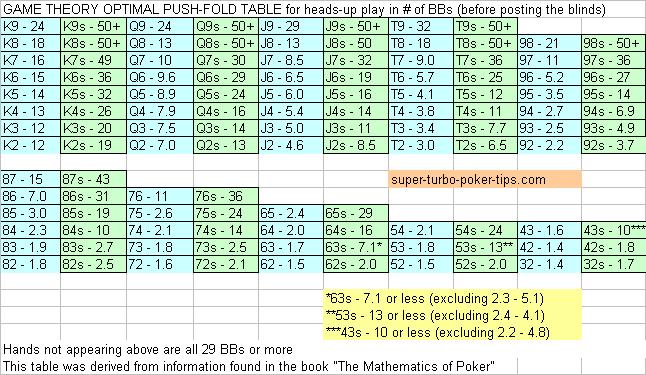|
Heads-Up Push-Fold Table
And here are the same push-fold ranges in list form:
20BB) 48% - 22,A2,K9,K4s,Q9,Q5s,J9,J7s,T9,T6s,98,96s,86s,75s,65s,54s
The image at the top of the page is a "game theory optimal" heads-up push-fold table (followed by the same info in list form). It shows the largest effective stack size (in big blinds) that should be pushed for each hand shown. So if you're dealt 84s (eight-four suited) and neither you nor your opponent had more than 10 BBs at the start of the hand, then you could shove all-in and no opponent could exploit you, but ... You must realize that an "unexploitable pushing range" for 10 BBs and an "unexploitable pushing hand" for 10 BBs are not the same. An "unexploitable pushing hand" would be a hand that would be profitable to shove even if you showed your opponent your hand before shoving. 84s does not qualify in that case. The only 8x hand that is unexploitable for a 10 BB shove on it's own is 87s. But 84s is part of the 10 BB unexploitable "range", which includes 22+,A2+,K2+,Q7+,Q2s+,J8+,J3s+,T8+,T4s+, 97+,95s+,87,84s+,76,74s+,64s+,53s+ and 43s. So you should indeed be shoving 84s for 10BBs or less. This also means you will need to be shoving ALL other qualifying hands including AA, KK, etc if you are going to use this strategy. Please also understand that game-theory-optimal and the dictionary definition of optimal are not the same. A "game theory optimal" push-fold range for a certain number of BBs is a range of hands that cannot be exploited by the opponent. That means that if your opponent is not calling your all-ins with the "game theory optimal" range of calling hands for that number of BBs, you'll automatically have an edge on him* whether he is calling too loosely or too tightly (* an edge on him for the hands when you have the button that is - for your big blind hands where he acts first preflop, that's another matter - see heads-up calling strategy ).
The good news is that almost no opponent will be calling with the "game theory optimal" range, because against most other opponents, using the "game theory optimal" calling range would be truly sub-optimal (bad). The reason is because very few players push all-in that loosely, and even fewer play a strict push-fold game. (Note: The "game theory optimal" calling range for a particular stack size is tighter than the "game theory optimal" pushing range. It's 67% vs 41% for 10BBs for example) Against an opponent that is playing strictly push-fold, the "game theory optimal" calling range would itself be unexploitable. So "game theory optimal" does not mean "most profitable". It just means unexploitable. The most profitable strategy against an unsuspecting opponent would be an exploitative strategy - one that deviates from "game theory optimal" push-fold based on how loosely or tightly he's calling your all-ins. You can choose to make this deviation or just stick with optimal push-fold strategy for your button hands. So what are the practical applications of all of this? Since the heads-up part of a Super Turbo Sit-N-Go usually only lasts a few hands, I believe you should be limping or min-raising your big pairs instead of just shoving all-in, especially the larger the stacks are and against weaker players. Because they won't have enough time to realize that when you limp or raise small, it's always with a big pair. Or you can simply choose to play strictly push-fold for anything 15BBs or less (on your button hands) and play a different way for larger stacks. There's nothing wrong with that. And against good players it might be your best option. Most of your opponents will not be calling loose enough against you in general, so I think the values shown in the table above make a pretty good default shoving range even if you limp your big pairs. This means (for example) you could play push-fold using the table with all the hands except for AA, KK and QQ. The fact that you're not also shoving the big pairs will mean you're no longer unexploitable. But I think it's more profitable against most players to do so. Once you have an idea of how loosely or tightly your opponent calls your shoves, you can adjust from there and try to exploit him if you choose. NOTE: I excluded most of the stronger hands from the table at the top of the page in order save space on my "cheat sheet". All of the omitted hands are at least 29+, which is deeper than you'd be playing push-fold anyway. Related Article:
Game Theory, Heads-Up Calling Strategy
|
